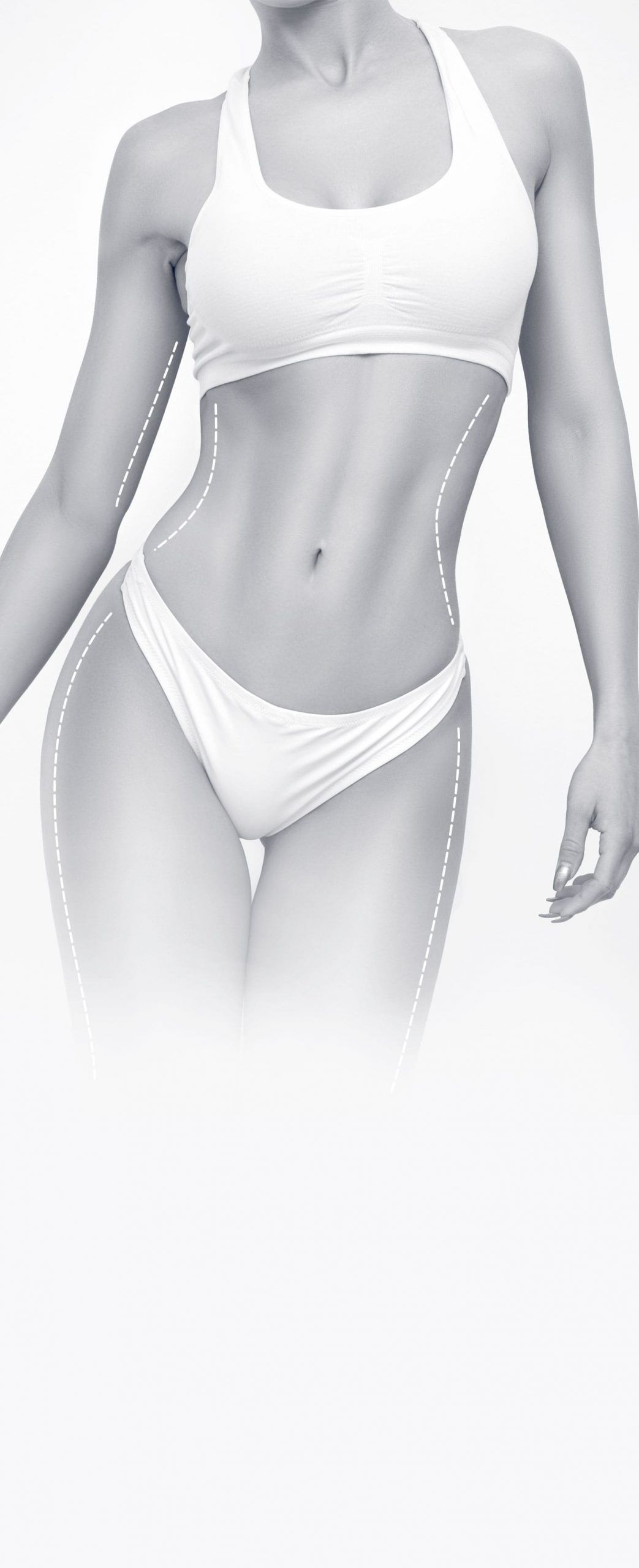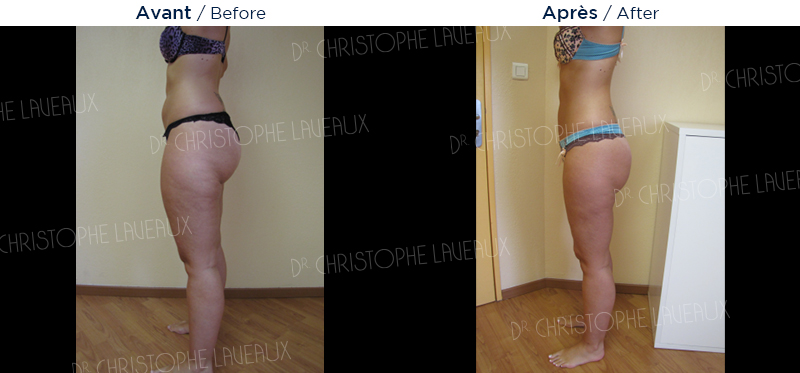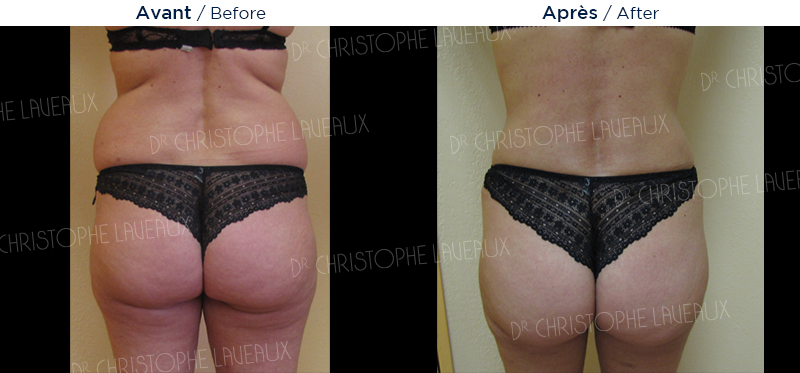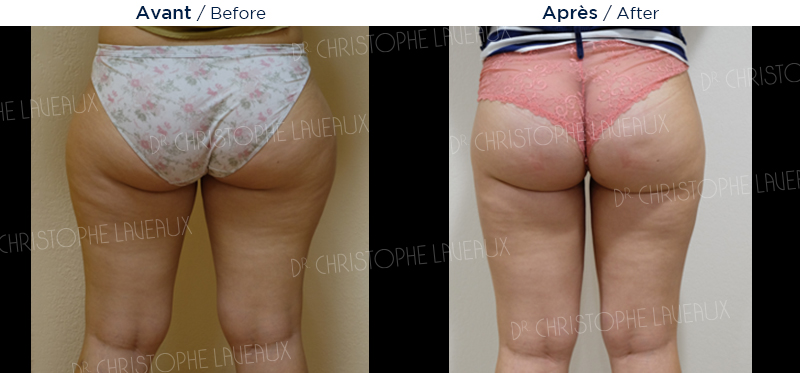Liposuction & lipofilling
Fat Liposuction
Liposuction permanently removes localised excess fat (steatomeries) that otherwise do not/only slightly vary, with weight fluctuation.
Liposuction reduces the number of fat cells using suction tubes. Since the fat cells do not have the capacity to divide, the result is permanent.
The remaining fat cells, however, have the ability to vary their volume in extreme weight change.
Several sites can be treated during the same operation, but the maximum amount of fat removed in one session should not exceed 5-10% of the overall weight of the patient to maintain the well-being of the body’s equilibrium.
Liposuction is not a treatment for obesity and should not lead to an unhealthy lifestyle.
Either the procedure is performed under assisted local anaesthesia (diazepine-induced analgesia) as an outpatient or, it is performed under general anaesthesia with a hospital stay of 10 to 24 hours when the volume of fat removed is very high.
Gentle liposuction refers to a technique performed under local anaesthesia using very fine suction tubes. The vacuum pressure used to remove the fat is gentle and is performed manually using syringes or with the use of equipment allowing to regulate the negative pressure.
The procedure varies from 30 minutes to 6 hours depending on the number of areas treated and the amount of fat to be removed. Almost invisible scars (3-5 mm) are often hidden in the natural folds.
The quality of the overlying skin is an essential factor to evaluate. Good quality skin is skin that tightens perfectly in the weeks following liposuction.
On the contrary, non-elastic skin, or skin with stretch-marks tightens poorly after liposuction. In the cases of damaged and/or excess skin, liposuction should be combined with a surgical skin tightening technique.
Surgical skin tightening is achieved either by :
- facelift or dermolipectomy techniques (techniques with scars) in case of very excessive skin
- or the innovative J-plasma Renuvion® technology (scar-free technique) if the excess skin is not too large.
Many areas can benefit from liposuction:
- the neck to correct a double chin (neck contouring) ;
- the face to improve facial contours ;
- the pectoral region in men
- breasts : liposuction on the breast has the advantage of not causing scarring but this technique is primarily intended for breasts with little or no excess skin and excellent skin that will tighten around the new smaller volume. In practice , it is used in conjunction with other techniques or to address breast asymmetry of mild volume ;
- the abdomen : during the examination the surgeon distinguishes the subcutaneous fat located in front of the abdominal muscles from the peri-visceral fat located behind the abdominal muscles. Only the subcutaneous fat can be sucked through liposuction.
If the skin is loose, a tummy tuck can be given in addition to liposuction ; - the back can be smoothed out and therefore some back folds and can disappear after liposuction ;
- the whole arm can be made thinner or the volume of the whole arm can be reduced. If there is significant excess skin, an additional arm lifting can be performed ;
- whole thighs can be slimmed down. If there is significant excess skin, an additional thigh lifting can be performed ;
- buttocks ;
- calves ;
- hips and love handle reduction : the skin is very tolerant and retracts very well ;
- the trochanter or ”saddlebags“ ;
- the insides of the knees ;
- ankles ;
- the pubis.


Once the operation is complete, a compression garment is placed over the dressing. It must be worn for 1 to 2 month to reduce swelling and pain, and to facilitate skin retraction.
Mild pain and fatigue can occur and can vary depending on the amount of fat removed.
Sometimes a daily anticoagulant therapy may be prescribed for a period of 8 to 10 days to reduce the risk of developing venous thrombosis.
Normal activity can be resumed 7-15 days after surgery depending on the type of employment. Sports activity can be resumed gradually after 3 to 4 weeks.
The result is generally very satisfactory and can start to be seen as of 3 to 4 weeks, after the disappearance of swelling.It only becomes permanent after six months once the skin is retracted.
As with any surgery, a number of complications can occur. But the likelihood of these complications is reduced in the hands of a qualified plastic surgeon and in the presence of a competent anaesthetist.
The patient’s compliance to instructions given by the surgeon is also essential and include :
- stopping smoking 1 month before and after the procedure (reduction of all risks) ;
- stopping the pill two months before and after the procedure (reducing the risk of phlebitis and pulmonary embolism) ;
- not taking aspirin for 10 days before and after the procedure (reduced risk of haematoma).
Serious complications are rare where well-planned, quality liposuction has been performed.
Rare complications that could occur include, but are not limited to risk of seroma, infection, scarring and thrombo-embolic complications (phlebitis).
In the event of a complication, appropriate measures will be taken.
Lipofilling
The patient’s fat is removed by a simple liposuction, which can be purified and then re-injected to increase the size of breasts, buttocks, chest and calves. Facial volume can also be restored.
Removal and reinjection of fat must take place during the same procedure as it is impossible to conserve.
It is not possible to take fat from another patient in order to carry out an autologous fat transfer. The donor and recipient must be the same, therefore eliminating the risk of rejection.
Fat reinjection is performed using fine cannulas via small incisions of 1 to 2 mm.
Lipofilling is a longer procedure however the postoperative effects are identical to those of a classic liposuction.
The patient will observe a 30 to 50% partial reduction of the transferred fat, which will stabilise within approximately 6 months. Fat cells can fail to survive the transfer from one area of the body to another therefore the surgeon only reinjects good quality fat in order to keep this loss at a minimum.
The patient’s compliance to the post-operative instructions is essential, in particular stopping smoking.
The final gain obtained depends on the initial fat reserves of the treated patient, the number of sessions performed and the rate of engraftment at each session.
Lipofilling also increases the volume of the breasts, buttocks, calves, pectorals, deltoid muscles, biceps or triceps. These fat injections can also help rejuvenate the back of the hands or face, correct scar hollows or treat intimate areas.








